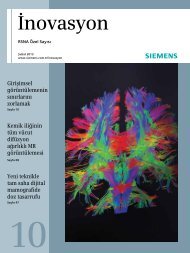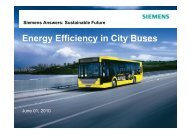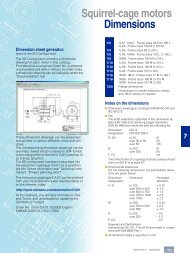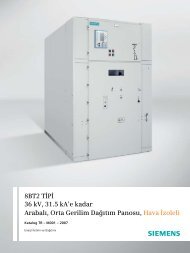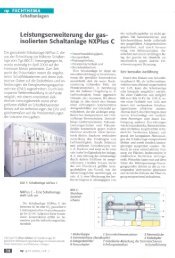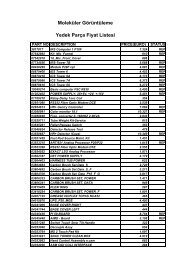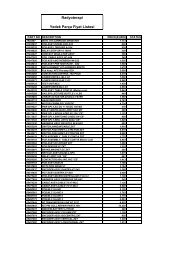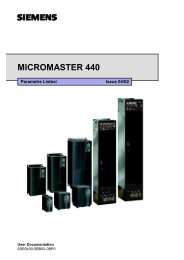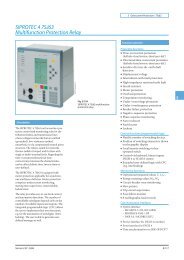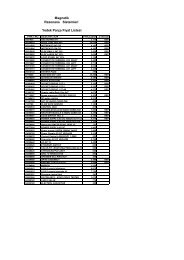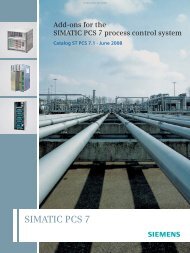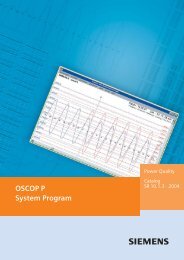Siemens 6.0 MW Offshore Wind Turbine
Siemens 6.0 MW Offshore Wind Turbine
Siemens 6.0 MW Offshore Wind Turbine
Create successful ePaper yourself
Turn your PDF publications into a flip-book with our unique Google optimized e-Paper software.
Turbina Sapiens in its natural habitat<strong>Siemens</strong> <strong>6.0</strong> <strong>MW</strong><strong>Offshore</strong> <strong>Wind</strong> <strong>Turbine</strong>www.siemens.com/wind
Sapiens /sæp.i.enz/(present participle from the latin. sapere)to have sense, to be wise, to knowTurbina (genus) Sapiens (species)
Turbina SapiensA different breed of wind turbineThe <strong>Siemens</strong> <strong>6.0</strong> <strong>MW</strong> offshore wind turbine redefinesthe wind industry standards for leanness, robustness andlifecycle profitability.Based on <strong>Siemens</strong> Direct Drive technology, the <strong>6.0</strong> <strong>MW</strong>turbine has 50% fewer moving parts than comparablegeared machines and a towerhead mass of less than 350tons. This unique combination of robustness and lowweight significantly reduces infrastructure, installation andservicing costs, and boosts lifetime energy output.its design criteria irrespective of the conditions.Its advanced diagnostics system provides comprehensivereal-time performance data and service requirementsand will keep track of lifetime use and its overall assetcondition. Even its user interface is clear and intuitive.It is no coincidence that a product of this simple beautyand intelligence has been created by <strong>Siemens</strong>. We areworld leaders in offshore wind power, with over 20 yearsof experience.Incorporating the aggregate intelligence of <strong>Siemens</strong>, the<strong>6.0</strong> <strong>MW</strong> offshore wind turbine thinks for itself. It constantlymanages its own operating load helping it remain within
Lean, robust and reliabletechnologyLeanThe <strong>Siemens</strong> <strong>6.0</strong> <strong>MW</strong> turbine is based on proven <strong>Siemens</strong>direct drive technology, offering the simplest and moststraightforward wind turbine design.Replacing the main shaft, gearbox and high-speed generatorwith only a low-speed generator eliminates two-thirds ofthe conventional drive train arrangement. As a result, thenumber of rotating and wear-prone parts is vastly reduced,and a <strong>Siemens</strong> direct drive wind turbine has 50% fewerparts than a comparable geared machine. Cruciallyimportant in offshore applications, of course, is thatmaintenance requirements drop accordingly.As a rule, the weight of large wind turbines has growndisproportionately to increases in power rating. The<strong>Siemens</strong> <strong>6.0</strong> <strong>MW</strong> wind turbine has conclusively brokenthe trend: with a towerhead mass of less than 60 tons per<strong>MW</strong> the <strong>6.0</strong> <strong>MW</strong> wind turbine is genuinely lean. This newlow-weight standard for offshore wind turbines offerssignificant cost benefits in terms of substructure requirements,shipping and installation, all made possible by the use of<strong>Siemens</strong>’ tried and tested direct drive technology.
RobustBenefiting from our unique offshore experience, the <strong>6.0</strong><strong>MW</strong> direct drive wind turbine is designed to exploit thebroadest range of offshore environmental conditions.Designed to IEC 1 Standards, the <strong>6.0</strong> <strong>MW</strong> turbine can bedeployed in any known offshore location. The structuralcapacity of all components is verified by full-scaletesting, and Highly Accelerated Lifetime Tests on allmain components and the complete nacelle demonstratetheir robustness.The entire turbine design is dedicated to offshoreapplication. All external surfaces and systems featureoffshore-grade corrosion protection, and the completelyenclosed nacelle is fitted with internal climate control.ReliableThe <strong>Siemens</strong> <strong>6.0</strong> <strong>MW</strong> wind turbine is designed not merelyto continue, but to enhance, the legendary reliability of<strong>Siemens</strong> wind turbines.Simple and robust, the direct drive technology offers thebest possible basis for high reliability.The rotor blades combine both lightness and strengththrough single-cast <strong>Siemens</strong> IntegralBlade® production.The nacelle, housing every part of the power system,forms a self-contained unit delivering medium voltagepower to the wind farm grid. As a result the turbine canbe fully pre-commissioned onshore, leaving only finalconnection to be performed after installation.Finally, with the extra nacelle space repurposed as anon-site workshop complete with crane and coffee machine,the maintenance process has been reinvented too.
Mould for the B75 Quantum BladeA choice of blades120m rotor for tip height restricted locationsThe 120 m rotor, standard equipment with the <strong>Siemens</strong>3.6 <strong>MW</strong> offshore workhorse, also allows the <strong>6.0</strong> <strong>MW</strong>turbine to be installed in locations where air trafficregulations make it difficult or impossible to exceeda maximum tip height of 150 m.154m rotor for maximum energy yieldThe 154m rotor, designed specifically for the <strong>Siemens</strong><strong>6.0</strong> <strong>MW</strong> turbine, has a swept rotor area of 18,600m 2 .It therefore maximizes energy yield at offshore locations,from inland waters with moderate wind resources to themost exposed offshore sites.IntegralBlade® technologyBoth the 120m and 154m rotors use blades manufacturedwith <strong>Siemens</strong>’ unique, patented IntegralBlade® technology.Instead of glueing the blades together from a number ofspars and shells, they are cast in a single process. This notonly enables both low weight and enormous strength,there are no glue joins which could potentially expose theblades to cracking and lightning damage.The aerodynamic and structural design of the blade for the154m rotor is based on <strong>Siemens</strong>’ Quantum Blade technology,incorporating unique airfoil profiles and redesigned tip androot sections. The root section uses <strong>Siemens</strong> “flatback”profiles to minimize root leakage and provide higher lift.The tip has also undergone a fine-tuning process to enhancelift. As a result, Quantum Blades offer superior performancein a wide range of wind speeds.
SWT-<strong>6.0</strong>-154 for maximum outputSwept area 18,600m 2Rated power at a wider range of wind speedsQuantum blade technologySWT-<strong>6.0</strong>-120 for maximum versatilitySwept area 11,500m 2Can be applied to the same foundation as the SWT-3.6-120Suitable for environments where maximum tip heightrestrictions apply, even onshore
To knowTo learnThe <strong>Siemens</strong> <strong>6.0</strong> <strong>MW</strong> wind turbine represents all thebrainpower of the world’s most experienced offshorewind turbine supplier – and more.The overall <strong>6.0</strong> <strong>MW</strong> turbine design is based on highlyproventechnology. All the classical virtues of <strong>Siemens</strong>turbines have been retained – ample dimensioning ofmain components, redundant safety systems, anddetails designed with the best engineering practices.The ground-breaking IntegralBlade® and direct drivetechnologies have been deployed in the field for years,and many core components are directly linked to turbinesproduced in large volumes. The main elements of thegenerator are scaled-up versions of their 3<strong>MW</strong> forebears.The converters are identical: the bigger machine simplyuses two 3<strong>MW</strong> converters side by side.Adding to the combined knowledge gained from fieldtestinga vast fleet of multi-megawatt offshore windturbines, <strong>Siemens</strong> continually strives to acquire in-depthunderstanding of every element in the wind turbine system.Fundamental to this process is rigorous testing ofcomponents and complete systems. At our R&Dheadquarters in Brande, Denmark, our test facility makesit possible to verify the structural capacity of everycomponent. The facility even enables Highly AcceleratedLifetime Tests on the complete nacelle, simulating 25 yearsof real life through 3-6 months of overload operation. Thisprocess ensures that <strong>Siemens</strong>’ legendary quality runsthrough every component of our wind turbines.Utilizing <strong>Siemens</strong>’ standard marinisation technologies,most of which were developed for the world’s first offshorewind farm at Vindeby, Denmark, in 1991, the turbine’senvironmental protection makes it eminently suited to themost severe offshore conditions
To senseOn top of its knowledge-based and robust technologyfoundation, the <strong>6.0</strong> <strong>MW</strong> turbine cleverly exploits anextensive list of proven and new <strong>Siemens</strong> innovations,including:Superior grid complianceAs more wind power enters the grid, there is a greateronus on wind turbine manufacturers to meet stringentgrid stability requirements. The <strong>Siemens</strong> NetConverter®system used by the <strong>6.0</strong> <strong>MW</strong> is designed for maximumflexibility in each wind turbine’s response to voltage andfrequency variations, fault ride-through capability, andoutput adjustment. The grid compatibility of <strong>Siemens</strong>turbines sets the benchmark for the wind industry, andthe advanced wind farm control system provides stateof-the-artfleet management.<strong>Siemens</strong> WebWPS SCADA systemThe <strong>6.0</strong> <strong>MW</strong> is equipped with the <strong>Siemens</strong> WebWPS SCADAsystem. Via a standard web browser, the system providesa variety of status views of electrical and mechanicaldata, operation and fault status, meteorological and gridstation data.<strong>Turbine</strong> Load Control (TLC)The <strong>Turbine</strong> Load Control system continuously monitorsthe structural loading on the wind turbine. In case theloads exceed normal values, e.g. as the consequenceof extreme meteorological conditions, the turbineautomatically regulates operation to bring loads backwithin the design envelope.In addition, the TLC system monitors the accumulatedfatigue loading on the turbine, thereby providing key inputfor fact-based asset management.High <strong>Wind</strong> Ride Through (HWRT)<strong>Wind</strong> turbines are normally programmed to shut downif the 10-minute mean wind speed exceeds 25 m/s. Thismay lead to severe challenges for the grid system if theturbines in large offshore wind farms are shut down moreor less simultaneously, e.g. at the passage of a gust front.The <strong>Siemens</strong> <strong>6.0</strong> <strong>MW</strong> turbine enhances grid stabilitywith its High <strong>Wind</strong> Ride Through system, which replacesthe fixed-threshold high wind shutdown with anintelligent load-based reduction in output power at veryhigh wind speeds.<strong>Turbine</strong> Condition Monitoring (TCM®)<strong>Siemens</strong>’ unique <strong>Turbine</strong> Condition Monitoring systemcompares the vibration levels of the main nacellecomponents with a set of established reference spectraand instantly detects deviations from normal operatingconditions. This allows <strong>Siemens</strong> to proactively plan theservice and maintenance of the wind turbines, as anyunusual event can be categorized and prioritized basedon severity.
Added efficiencies inlogistics, pre-commissioningand installation<strong>Wind</strong> turbine design evolution is affecting far more thanjust the design itself. The <strong>Siemens</strong> <strong>6.0</strong> <strong>MW</strong> turbine’smanufacturing, assembly and installation processes areprepared with genuine industrialization in mind, creatinga scalable production model that will reduce both deliverytimes and costs throughout the value chain.A modular nacelle arrangement will reduce onshoreport assembly requirements dramatically. And with theentire electrical system – including the medium voltagesystem and the full converter – included in the nacelle,pre-commissioning testing can be carried out at quayside,reducing offshore work to a minimum.
Further improvements in safetySafety is at the heart of all <strong>Siemens</strong> operations. Fromproduction, through installation, operation, and service,<strong>Siemens</strong> strives to set the standard.Onshore pre-commissioning and testing significantlyreduce the amount of work that needs to be done inriskier offshore conditions.While the simplified direct drive concept in itself reducesservice requirements, offshore maintenance has beencompletely rethought.Service technicians can enter the turbine via the helihoistplatform or via conventional tower access, where a newgangway system enables safer access at rough seaconditions.The spacious nacelle, housing far fewer parts than usual,provides technicians with safe and easy access to all keycomponents.
The world’s first wind farm at Vindeby, Denmark. Installed by <strong>Siemens</strong> in 1991.The turbines in this project are still running today<strong>Siemens</strong> <strong>Wind</strong> Power– the offshore leaderThe world is seeing a dramatic increase in the nature andscope of offshore wind power plants. As larger projectshead farther out to sea, the reliability of the wind turbineis paramount.Given the logistical challenges of offshore projects,where even the smallest issue can amplify costs, havingtechnology that performs to order under some of theharshest operating conditions on the planet is crucial.With good reason, <strong>Siemens</strong> is the obvious first choice forassured delivery of high-performing technology. Fromthe very beginning, the company has been the undisputedleader in offshore wind power, and remains so today.Landmark projects include the world’s first offshorewind farm at Vindeby, Denmark. Installed in 1991, the11 turbines in this project are still operating today.The first offshore wind farm using multi-megawattturbines was also delivered by <strong>Siemens</strong>. Installed in 2000in a single arc off Copenhagen, the 20 turbines of theMiddelgrunden project remain the iconic symbol of theoffshore wind industry.For many years the 165<strong>MW</strong> Nysted offshore wind farm,installed in 2003, held the record as the world’s largestoffshore project, a record only broken in 2009 by our200<strong>MW</strong> Horns Rev II project. The 1GW London Arrayproject, currently being developed, will once againredefine the capabilities of offshore wind power and pavethe way for green energy to become the cornerstone of theglobal energy mix. Not surprisingly, all of these projects aredelivered by <strong>Siemens</strong>.With over 2GW of installed offshore capacity, the <strong>Siemens</strong>offshore organisation has deservedly earned the reputationfor having the deepest experience and world class projectmanagement capabilities. No wonder, then, that despitethe immense challenges of installing and commissioningoffshore wind farms, every offshore project undertaken sofar by <strong>Siemens</strong> <strong>Wind</strong> Power has been delivered on time andwithin budget.Our infrastructure capabilities are no less proven. <strong>Siemens</strong>has a wealth of experience of building and integratingsubstations for national grids and is the only company tohave designed, built and delivered offshore substationsof up to 500 <strong>MW</strong>.And with our dynamic modelling of wind turbine arraysand grid connections through our Power TechnologiesInternational (PTI) teams, we lead in dealing withunknowns at the beginning of a project, rather thanduring it.
The installationof a <strong>6.0</strong><strong>MW</strong> windturbine onshore
Technical SpecificationsSWT-<strong>6.0</strong>-154RotorType3-bladed, horizontal axisPositionUpwindDiameter154 mSwept area 18600 m²Speed range5-11 rpmPower regulation Pitch regulation with variable speedRotor tilt6 degreesBladeTypeSelf-supportingBlade Length75 m (B75)Aerodynamic profile <strong>Siemens</strong> proprietary airfoils,FFA-W3-XXXMaterialGRESurface glossSemi-gloss,
42311Quantum Blade3Nacelle2• Unique design and manufacturing process• IntegralBlade® one-piece moulding formaximum strength• Optimized aerodynamics for medium to highwind conditions• Increased length for higher energy yield• Blade root – designed for minimized rootleakage and increased liftDirect drive generator• Permanent magnet design• Totally enclosed, easy to handle andlightweight design• Optimum reliability and efficiency4• Solid and lightweight structure• Spacious, ergonomic design – maximumserviceability• 50% fewer parts compared to geared turbinesCooling• Simple and robust LiquidLink® watercooling system• Top-mounted passive cooling radiators• High-efficient two-stage cooling as functionof power
Published by and copyright © 2011:<strong>Siemens</strong> AGEnergy SectorFreyeslebenstrasse 191058 Erlangen, Germany<strong>Siemens</strong> <strong>Wind</strong> Power A/SBorupvej 167330 Brande, Denmarkwww.siemens.com/windFor more information, please contactour Customer Support Center.Phone: +49 180 524 70 00Fax: +49 180 524 24 71(Charges depending on provider)E-mail: support.energy@siemens.com<strong>Wind</strong> Power DivisionOrder No. E50001-G310-A186-X-7600Printed in GermanyDispo 34804 c4bs No. 7491MCS 11.11.1Printed on elementary chlorine-freebleached paper.All rights reserved.Trademarks mentioned in this documentare the property of <strong>Siemens</strong> AG, its affiliates,or their respective owners.Subject to change without prior notice.The information in this document containsgeneral descriptions of the technical optionsavailable, which may not apply in all cases.The required technical options should thereforebe specified in the contract.



